| C H A P T E R 3 |
|
Servicing Customer Replaceable Devices |
This chapter describes how to replace the hot-swappable and hot-pluggable customer replaceable units (CRUs) in the Sun Fire X4150 Server.
The following topics are covered:
Hot-pluggable devices are those devices that you can remove and install while the server is running, but you must perform administrative tasks before or after installing the hardware (for example, mounting a drive).
In the Sun Fire X4150 Server, hard drives and SSD drives are hot-pluggable. To hot-plug a drive you must take the drive offline (to prevent any applications from accessing it, and to remove the logical software links to it) before you can safely remove it. See Section 3.2, Servicing the Drives.
Hot-swappable devices are those devices that can be removed and installed while the server is running without affecting the rest of the server’s capabilities.
In the Sun Fire X4150 Server, the following devices are hot-swappable:
| Note - The chassis-mounted drives can be hot-swappable, depending on how they are configured. See Section 3.2, Servicing the Drives. |
The following topics are covered for hard drive or SSD:
| Note - These are customer-replaceable units. |
FIGURE 3-1 shows the front panel of a server with 8 hard drives.

The X4150 server supports installing SSDs in the drive bays. Each SSD provides at least 32Gb of SATA capacity.
TABLE 3-2 shows drive numbers for a server with 4 SSDs and 4 hard drives. FIGURE 3-1 shows the front panel of a server with 8 drives.
The Sun Fire X4x50 servers support solid-state drives (SSDs) under the following conditions:
Sun Fire X4150 with on-board controller:
Sun Fire X4150 with both HBA and on-board controller:
The remaining slots can be filled with up with hard drives that can equal up to 4.
| Note - You can create RAID volumes with SAS hard drives and SATA SSDs, as long as you do not mix them in a same volume. |
The following cable kits are used for the HBA controller when using hard drives and SSDs:
FIGURE 3-2 shows the hard drive and SSD LED status indicators.

1 |
|
|||
2 |
|
The system is running and the drive is faulty. The front and rear panel Service Required LEDs are also lit if the system detects a drive fault. |
||
3 |
|
Hard drives or SSD drives can be hot-plugged or cold-plugged. Drives in the Sun Fire X4150 Server might be hot-pluggable, depending on the drive configuration.
To hot-plug a drive you must take the drive offline (to prevent any applications from accessing it, and to remove the logical software links to it) before you can safely remove it.
To remove a drive from a Sun Fire X4150 Server:
1. Identify the drive you wish to remove.
The amber Service Required LED might be lit. For specific drive locations, see Section 3.2.1, Sun Fire X4150 Server Drive Guidelines.
2. Determine if the drive can be hot-plugged, or cold-plugged.
The following conditions might prevent you from hot-plugging a drive. You must power off the server, if the drive:
a. Unconfigure the drive, as required. You must take the drive offline (to prevent any applications from accessing it, and to remove the logical software links to it) before you can safely remove it.
See one of the following HBA documents:
For Sun StorageTek: Sun StorageTek RAID Manager Software User's Guide
For LSI MegaRAID Storage Manager (MSM): x64 Server Utilities Reference Manual
4. On the drive you plan to remove, push the drive release button to open the latch ([1] FIGURE 3-3).
5. Grasp the latch [2] and pull the drive out of the drive slot [3].

|
Caution - The latch is not an ejector. Do not bend it too far to the right. Doing so can damage the latch. |
FIGURE 3-3 Locating the Drive Release Button and Latch

Installing a hard drive or SSD drive into the Sun Fire X4150 Server is a two-step process. You must first install a drive into the drive slot, and then configure that drive to the server.
To install a drive or SSD drive into a Sun Fire X4150 Server:
1. If necessary, remove the blank panel from the chassis.
The Sun Fire X4150 Server might have as many as seven blank panels covering unoccupied drive slots.
2. Determine the drive slot location for the replacement drive.
If you removed an existing drive from a slot in the server, you must install the replacement drive in the same slot as the drive that was removed. Drives are physically addressed according to the slot in which they are installed. See TABLE 3-1 for drive locations.
3. Slide the drive into the drive slot until it is fully seated (FIGURE 3-4).

4. Close the latch to lock the drive in place.
Configure the drive. See one of the following HBA documents:
For Sun StorageTek: Sun StorageTek RAID Manager Software User's Guide
For LSI MegaRAID Storage Manager (MSM): x64 Server Utilities Reference Manual
Restore power to the server. Do the procedure described in Section 6.4, Powering On the Server.
All drive slots in the Sun Fire X4150 Server must have drive fillers in place during operation to maintain airflow. To remove fillers, pull the ejector and pull the filler out of the chassis.
The following topics are covered:
| Note - This is a customer-replaceable unit. |
Seven pairs of fan modules are located under the top cover door, providing N+1 cooling redundancy. Each fan module contains two fans mounted in an integrated, hot-swappable CRU.
If a fan module fails, replace the fan as soon as possible to maintain server availability.
Each fan module contains LEDs that are visible when you open the fan tray access door. TABLE 3-4 describes fan tray module LEDs and their functions. FIGURE 3-6 shows fan tray module LED locations.
FIGURE 3-5 Fan Module Status LEDs
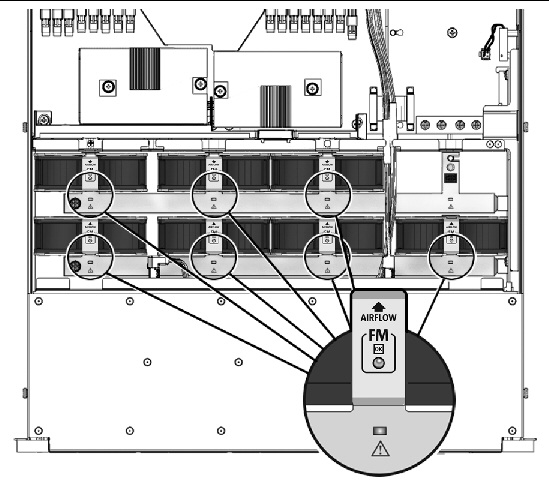
See Section 1.2, Sun Fire X4150 Server Chassis Overview for more information about system status LEDs.
The following LEDs are lit when a fan module fault is detected:
If an overtemperature conditions occurs, the front panel CPU overtemperature LED becomes lit and a message is displayed on the console and logged by the ILOM.
The system Overtemp LED might be lit if a fan fault causes an increase in system operating temperature. See Section 1.3, Sun Fire X4150 Server Front Panel Features for more information about identifying and interpreting system LEDs.

|
Caution - Hazardous moving parts. Unless the power to the server is completely shut down, the only service permitted in the fan compartment is the replacement of the fan modules by trained personnel. |
1. Extend the server into the maintenance position.
See Section 2.5, Extending the Server to the Maintenance Position.
2. Unlatch the fan module door.
Pull the release tabs back to release the door. Open the top cover toward the rear of the server.
3. Identify the faulty fan module with a corresponding Service Required LED.
The Fan Fault LEDs are located on the fan board.
4. Using thumb and forefinger in between the two fans, pull the fan module up and out of the connector (FIGURE 3-6).
FIGURE 3-6 Removing a Fan Module.
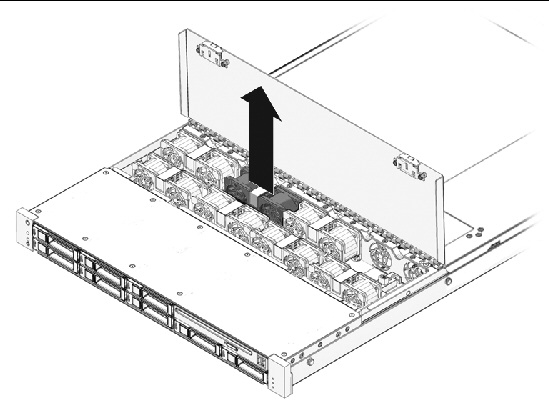
1. With the top cover door open, install the replacement fan module into the server (FIGURE 3-7).
The fan modules are keyed to ensure that they are installed in the correct orientation.
FIGURE 3-7 Installing a Fan Module
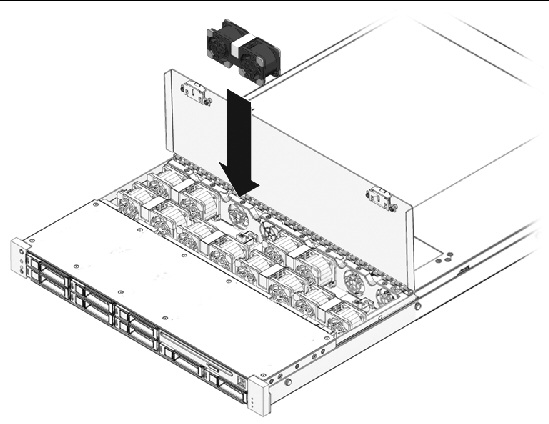
2. Apply firm pressure to fully seat the fan module.
3. Verify that the Fan Fault LED on the replaced fan module is not lit.
5. Verify that the Top Fan LED, Service Required LEDs, and the Locator LED/Locator button are not lit.
See Section 1.2, Sun Fire X4150 Server Chassis Overview for more information about identifying and interpreting system LEDs.
Some versions of the Sun Fire X4150 Servers are equipped with redundant hot-swappable power supplies. Redundant power supplies enable you to remove and replace a power supply without shutting the server down, provided that the other power supply is online and working.
If a power supply fails and you do not have a replacement available, leave the failed power supply installed to ensure proper air flow in the server.
| Note - This is a customer-replaceable unit. |
The following topics are covered:
The following LEDs are lit when a power supply fault is detected:
See Section 3.4.2, Power Supply LED Reference for power supply LED information.
See Section 1.3, Sun Fire X4150 Server Front Panel Features and Section 1.4, Sun Fire X4150 Server Rear Panel Features for more information about identifying and interpreting server LEDs.
Each power supply contains LEDs on the back panel of the system.
FIGURE 3-8 Power Supply Status LEDs
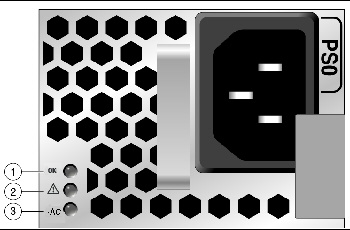

|
Caution - Hazardous voltages are present. To reduce the risk of electric shock and danger to personal health, follow the instructions. |
1. Identify which power supply (0 or 1) requires replacement.
A lit (amber) failure LED on a power supply indicates that a failure was detected.
2. Gain access to the rear of the server where the faulty power supply is located.
3. Release the cable management arm (CMA) (FIGURE 3-9).
The CMA is located at the rear of the server rack.
FIGURE 3-9 Releasing the Cable Management Arm
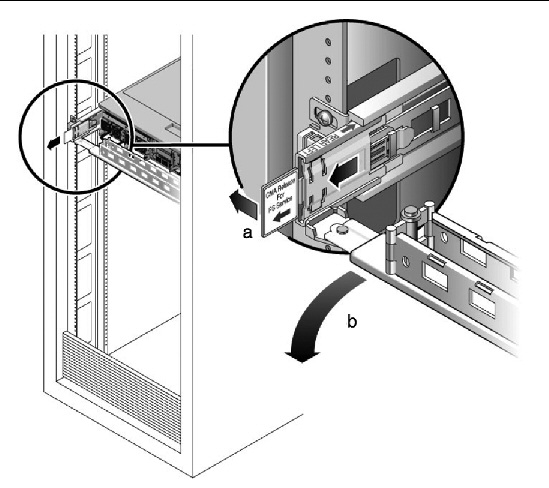
b. Rotate the cable management arm out of the way so that you can access the power supply.
4. Disconnect the power cord from the faulty power supply.
5. Grasp the power supply handle and press the release latch (FIGURE 3-10).
6. Pull the power supply out of the chassis.
FIGURE 3-10 Power Supply Release Handle
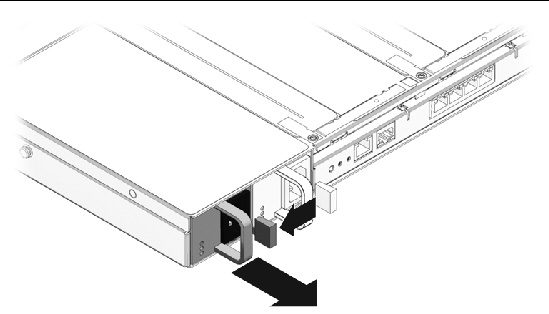
1. If you are installing a second power supply in a one power supply system, remove the filler panel. Grasp the vertical wall, and pull the filler panel straight out.
2. Align the replacement power supply with the empty power supply chassis bay.
3. Slide the power supply into the bay until it is fully seated (FIGURE 3-11).
FIGURE 3-11 Installing a Power Supply

4. Reconnect the power cord (or cords) to the power supply (or supplies).
Verify that the AC Present LED is lit.
5. Close the CMA, inserting the end of the CMA into the rear left rail bracket (FIGURE 3-9).
6. Verify that the following LEDs are not lit:
| Note - See Section 1.3, Sun Fire X4150 Server Front Panel Features and Section 1.4, Sun Fire X4150 Server Rear Panel Features for more information about identifying and interpreting system LEDs. |
7. Verify the status of the power supplies.
Solaris OS: At the -> prompt, type the show environment command.
The DVD-ROM drive and front USB board are mounted in a removable module that is accessible from the front panel of the system. The DVD/USB module must be removed from the drives cage to service the drives backplane.
| Note - This is a customer-replaceable unit. |
1. Remove media from the drive.
See Section 2.4, Powering Off the Server.
3. Attach an antistatic wrist strap.
See Section 2.7, Performing Electrostatic Discharge and Antistatic Prevention Measures.
4. Remove the Sun Fire X4150 Server HD7 hard drive.
See Section 1.2, Sun Fire X4150 Server Chassis Overview for drives locations.
5. Release the DVD/USB module from the drives backplane (FIGURE 3-12).
Use the finger indent in the drives bay below the DVD/USB module to detach the module from the backplane.
6. Slide the DVD/USB module out of the drives cage.
7. Place the module on an antistatic mat.
FIGURE 3-12 Removing the DVD/USB Module

1. Slide the DVD/USB module into the front of the chassis until it seats (FIGURE 3-13).
2. Install the drive you removed during the DVD/USB module removal procedure.
See Section 6.4, Powering On the Server.
FIGURE 3-13 Installing the DVD/USB Module
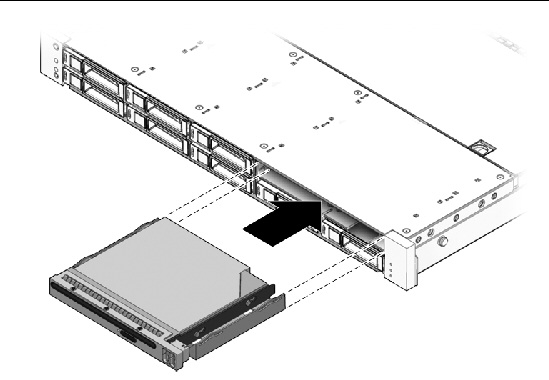
Copyright © 2009 Sun Microsystems, Inc. All rights reserved.